Arizona features some of the most breathtaking scenery in North America. From the majesty of the Grand Canyon to the stark beauty of the badlands, there is plenty to see in The Grand Canyon State. Arizona is also home to many animal species ranging from rattlesnakes to roadrunners. Amidst all the coyotes and jackrabbits, you’re sure to find a variety of spider species as well. There are many spiders in Arizona, and they run the gamut from giant tarantulas to tiny jumping spiders. Here is a list of 10 spiders in Arizona that you may encounter if you travel to or live there.
#10: Arizona Brown Spider
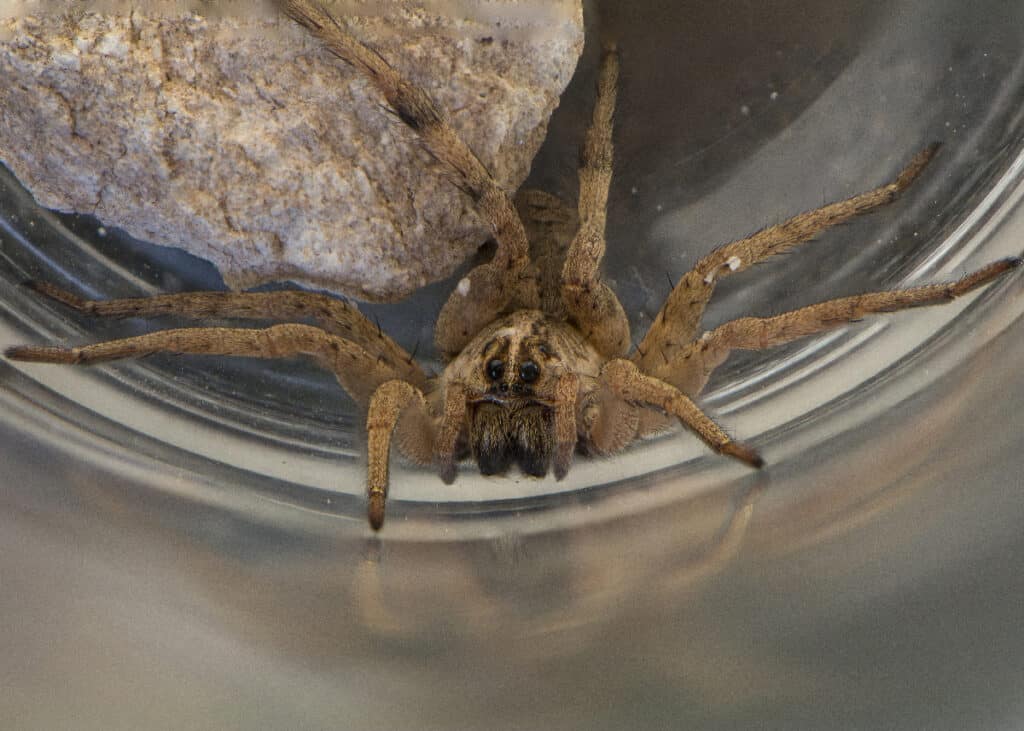
©iStock.com/Ledzeppelinriff
The Arizona brown spider is a species of brown recluse found in Arizona, hence its name. Like its cousin, the Arizona brown spider possesses a toxic bite that can cause necrosis and skin damage. If you’re bitten by one, it’s a good idea to consult a physician right away, although the bite is rarely fatal.
Arizona brown spiders measure around 6 to 13 millimeters long, with males measuring smaller than females. They appear yellowish or light brown and possess a distinctive violin-shaped marking on their bodies.
You’re most likely to find Arizona brown spiders outside, although these spiders occasionally enter buildings searching for food. Unlike most other spiders in Arizona and elsewhere, Arizona brown spiders do not use web to catch food. Instead, they actively hunt at night for small insects.
#9: Beach Wolf Spider
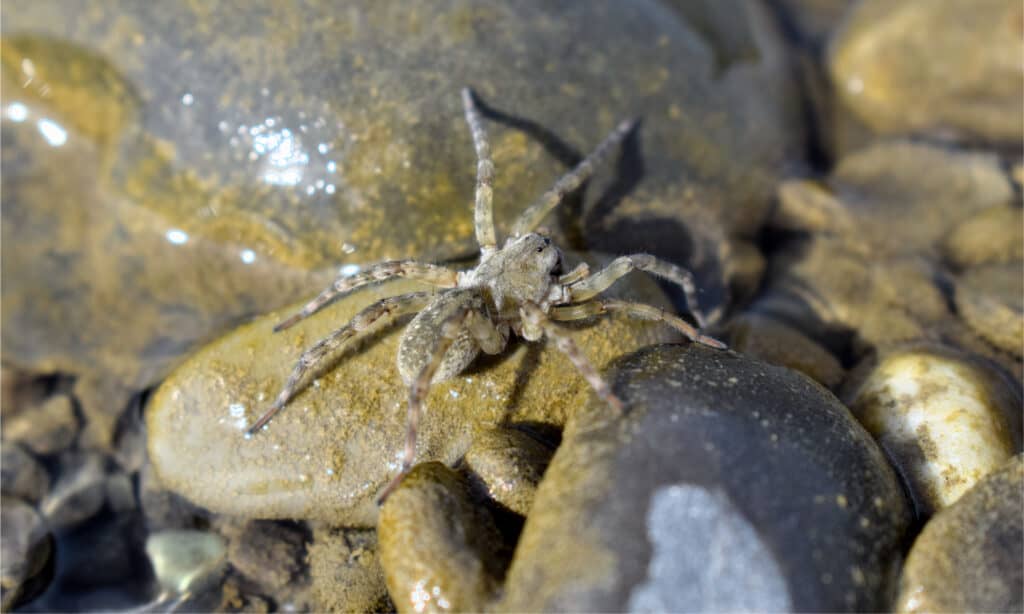
The beach wolf spider camouflages itself by burying itself in sand.
©Simone Morris/Shutterstock.com
Beach wolf spiders belong to the wolf spider family, Lycosidae, from the Greek word for wolf, lúkos. You can find these spiders in Arizona and throughout the United States and parts of Canada. They typically prefer to spend time near beaches, deserts, or anywhere else they can find sand to hide in during the day.
Most beach wolf spiders measure between 11 to 15 millimeters long, with females measuring larger than males. These spiders vary in color from white to brown and tan. They possess spotted markings along their body that help them blend into the sand. This camouflage is not only useful for avoiding predators but also for helping them to sneak up on and ambush prey.
The bite of a beach wolf spider is poisonous and can be quite painful. However, these spiders rarely bite people.
#8: Western Desert Tarantula

The western desert tarantula digs deep burrows to protect itself during the day from the hot desert sun.
©Ryan M. Bolton/Shutterstock.com
Also known as the Arizona or Mexican blonde tarantula, western desert tarantulas belong to the family Theraphosidae. You can find these giant spiders in Arizona and the desert regions of New Mexico and Mexico. They dig deep burrows in the soil and are hardy enough to resist harsh desert temperatures.
Western desert tarantulas measure from 8 to 13 centimeters long, with males measuring smaller than females. While females appear mostly tan – hence the term “blond” in their name – males have black legs, a copper cephalothorax, and a reddish abdomen.
Compared to most other spiders, western desert tarantulas have a long lifespan. Females can live anywhere from 24 to 30 years, and males can live from 5 to 10 years. Although these spiders are venomous, their bite is not particularly dangerous to humans. In fact, they are one of the least venomous spiders in their family.
#7: Golden Huntsman Spider
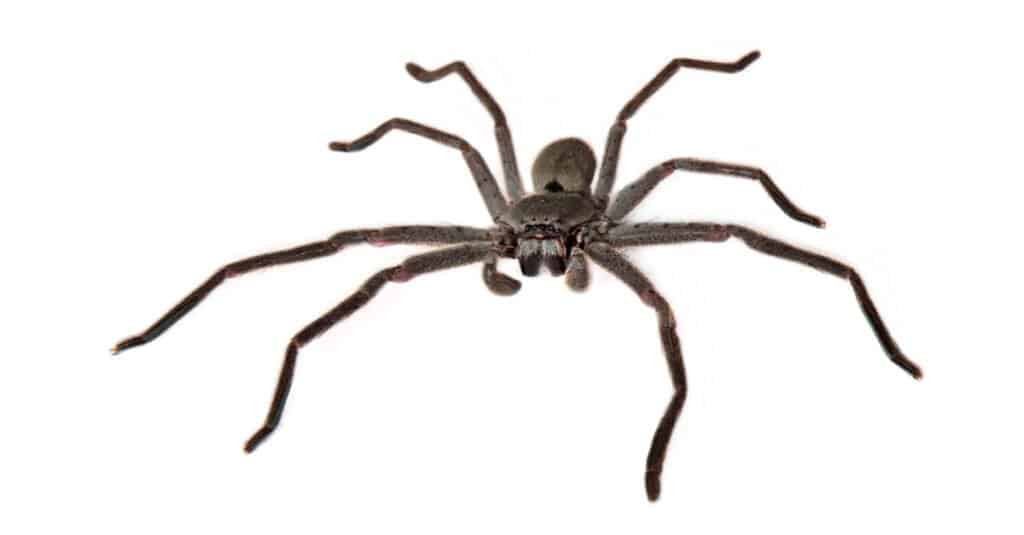
The golden
huntsman spider
can measure anywhere from 10 to 50 millimeters long.
©John McQueen/Shutterstock.com
Also known as the giant crab spider, the golden huntsman spider is one of the largest spiders in Arizona and North America in general. It gets its name from its giant size and its color.
Golden huntsman spiders can measure anywhere from 10 to 50 millimeters long. Their bodies are covered in short, sandy brown hair, while their legs are usually darker brown.
These giant spiders can run sideways like a crab and climb vertical services or even upside down. This is one way to distinguish them from the similarly-sized wolf spider, which cannot climb such surfaces. That said, like a wolf spider, they don’t use webs to catch prey but rather are active hunters that rely on speed, power, and the element of surprise.
While they are venomous and their bite is painful, humans face little danger from golden huntsman spiders.
#6: Arizona Black Hole Spider

The Arizona black hole spider belongs to the family Filistatidae or crevice weaver spiders. You can find this spider in Arizona and several neighboring states, including New Mexico, California, and Nevada.
Female Arizona black hole spiders measure around 13 millimeters long, with males measuring smaller and possessing longer legs but a thinner body. Both sexes are black, and their bodies have a velvety texture.
The Arizona black hole spider gets its name from the unique web that it weaves. Like other crevice weaver spiders, the female Arizona black hole spider creates a web shaped like a tube out of silk. It builds its web inside cracks or holes, with threads branching out from the entrance. While the web is not sticky, it is still efficient at snaring unsuspecting prey. Arizona black hole spiders are relatively harmless, and their bite rarely causes more than mild pain and some swelling.
#5: Western Parson Spider
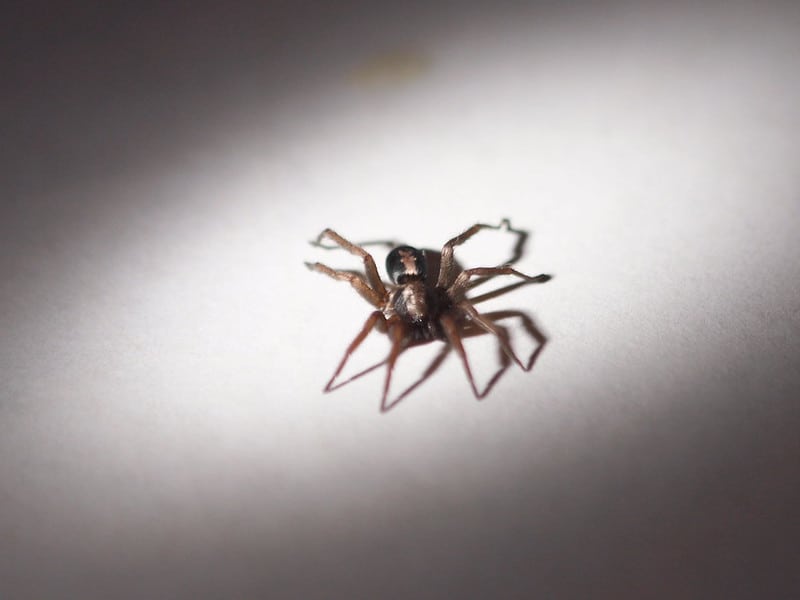
©lostinfog, CC BY-SA 2.0 <https://creativecommons.org/licenses/by-sa/2.0>, via Wikimedia Commons – License
The western parson spider gets its name from its geographic distribution and its distinctive markings. You can find these spiders in Arizona and throughout the western United States. The white markings on its abdominal area resemble the 18th-century cravats worn by members of the clergy, also known as a parson.
Most specimens measure from 10 to 20 millimeters long, with females measuring larger than males. Their bodies are covered in black or dark grey hairs aside from the white markings on the abdomen and white dots near the spinneret.
Western parson spiders are part of the ground spider family Gnaphosidae and so do not weave webs. Rather, they are active hunters and venture out of their burrows at night searching for prey. Like other ground spiders, their venom poses little to no threat to humans, although their bite is still quite painful.
#4. Hirsute Paradise Spider

The hirsute paradise spider belongs to the jumping spider family Salticidae. A native to North America, you can find this spider in Arizona and many other surrounding states.
As their name suggests, hirsute paradise spiders can be quite colorful. Their bodies are mostly black, dark brown, or tan, while their legs and faces feature bright splashes of color ranging from orange to red to pink to blue.
Like other jumping spiders, hirsute paradise spiders do not use webs to catch their prey. Instead, they rely on their keen eyesight and excellent jumping abilities to spring on unsuspecting insects and other arthropods. Although they are poisonous, their bite poses little threat to humans. At worst, a bite from one causes some mild pain and swelling for a few days.
#3. Western Black Widow
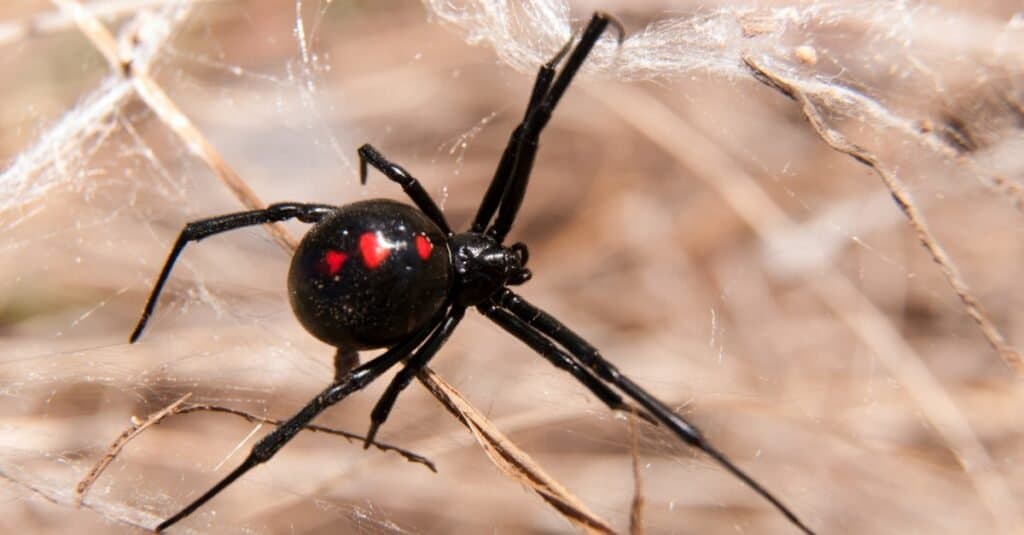
The western black widow spider is distributed throughout the half of the west of North America.
©Sari ONeal/Shutterstock.com
The western black widow is one of the most dangerous spiders in Arizona. This venomous spider is found throughout western North America and is a member of the cobweb spider family Theridiidae. Like other cobweb spiders, it spins strong, sticky webs that it uses to catch its prey.
Like other black widows, the western black widow possesses a black body and a distinctive hourglass-shaped marking on its body. This hourglass shape normally appears red but can also be white or yellow. Females usually measure from 14 to 16 millimeters long, while males measure about half as long.
Female western black widows possess a potent venom that contains a neurotoxin capable of causing pain, nausea, and fever. A bite may prove fatal on rare occasions, but usually only in small children with weak immune systems. Additionally, while females occasionally cannibalize males after courtship, it is rare.
#2: Western Spotted Orb Weaver
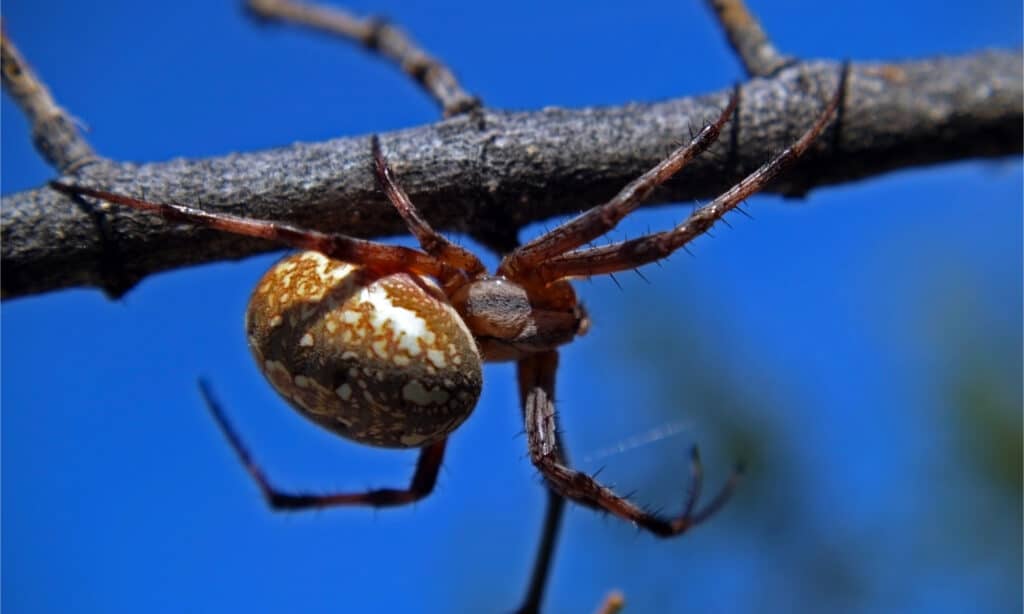
The western spotted
orb weaver
features distinctive brown and yellow markings.
©Deep Desert Photography/Shutterstock.com
The western spotted orb weaver is a member of the orb-weaver family, Araneidae. This spider is found throughout the western United States and South America and the Galapagos Islands.
Female western spotted orb weavers measure from 9 to 18 millimeters long, while males measure from 6 to 13 millimeters long. Males and females feature a distinctive brown and yellow spotted pattern on their abdomens. Additionally, the abdomen is bisected by a thin light brown band that runs through yellow triangles and dots up the abdomen.
The western spotted orb weaver creates a large, circular web like other orb weavers. It usually spins its web in open areas with little foliage and will hang upside down in its web while waiting for prey to get ensnared in the silk threads. It feeds on a variety of insect prey, and its bite poses little threat to humans.
#1. Grand Canyon Black Tarantula
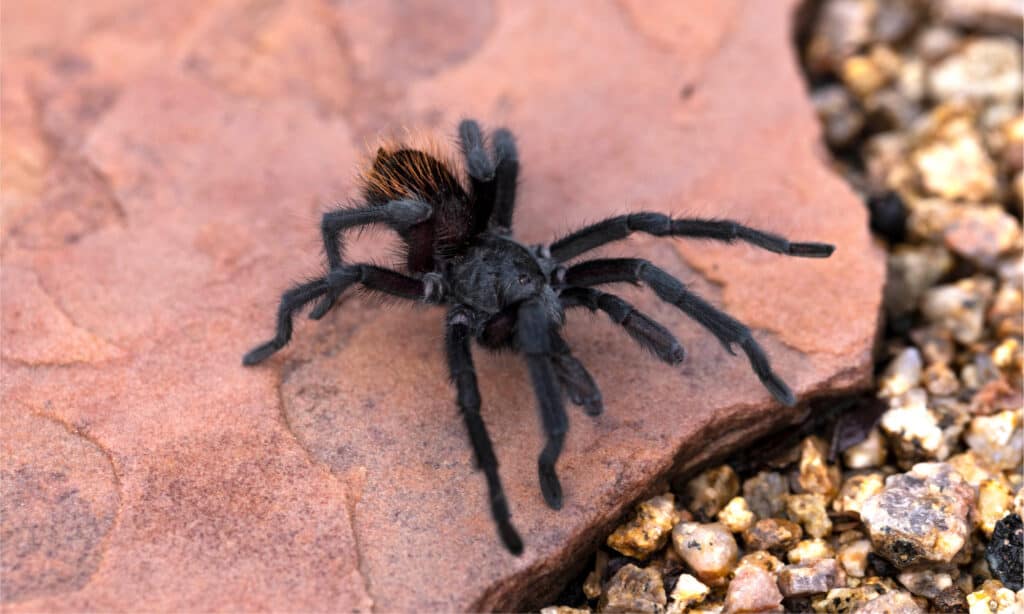
The Grand Canyon black tarantula is found almost exclusively in and around the Grand Canyon.
©Malisa Nicolau/Shutterstock.com
The Grand Canyon black tarantula is one of the largest spiders in Arizona. It gets its name from its dark color and habitat, as these spiders mostly live in and around the Grand Canyon.
Grand Canyon black tarantulas can grow to nearly 4 inches long from leg tip to leg tip. That said, spiders that live inside the Grand Canyon tend to measure larger than those outside the canyon. They normally appear dark brown or black, although the hairs on their abdomens can look reddish-orange.
Like other tarantulas, these giant spiders build burrows in the ground lined with silk to prevent them from collapsing. They leave their burrows almost exclusively at night to hunt or search for mates. Their prey is made up mostly of insects and some small rodents.
Summary of 10 Spiders in Arizona
| Rank | Spider |
|---|---|
| 1 | Grand Canyon Black Tarantula |
| 2 | Western Spotted Orb Weaver |
| 3 | Western Black Widow |
| 4 | Hirsute Paradise Spider |
| 5 | Western Parson Spider |
| 6 | Arizona Black Hole Spider |
| 7 | Golden Huntsman Spider |
| 8 | Western Desert Tarantula |
| 9 | Beach Wolf Spider |
| 10 | Arizona Brown Spider |
Bonus: Reptiles Found in Arizona that Are Not Spiders
While we have presented 10 different spiders found in Arizona, here are some bonus reptiles that also call Arizona home!
Here are some additional reptiles:
- Great Plains skink: The Great Plains skink is a lizard species native exclusively to North America.
- Greater short-horned lizard: The Greater Short-Horned Lizard, often referred to as the Mountain Short-Horned Lizard is a lizard species native to the western regions of North America.
- Sagebrush lizard: The sagebrush lizard, also known as the sagebrush swift, is a prevalent phrynosomatid lizard species discovered in the mid to high-altitude regions of the western United States.
- Western terrestrial garter snake: The western terrestrial garter snake is a colubrid snake species native to western North America.
- Prairie rattlesnake: Crotalus viridis is a venomous pit viper species indigenous to the western United States, southwestern Canada, and northern Mexico.
- California kingsnake: The California kingsnake is a nonvenomous colubrid snake native to the western United States and northern Mexico, thriving in diverse habitats.
- Western box turtle: Terrapene ornata is a North American box turtle species, occasionally known as the western box turtle or the ornate box turtle.
- Speckled rattlesnake: Crotalus mitchellii is a venomous pit viper species belonging to the Viperidae family.
- Heloderma: Heloderma is a genus of toxic fern lizards encompassing five venomous species.
- Madrean alligator lizard: The Madrean alligator lizard belongs to the Anguidae family and is a lizard species.
The photo featured at the top of this post is © davemhuntphotography/Shutterstock.com
FAQs (Frequently Asked Questions)
What is the largest spider in Arizona?
The largest spider in Arizona is the Arizona blond tarantula. These spiders can reach up to 6 inches across and weigh 1 to 3 ounces.
Thank you for reading! Have some feedback for us? Contact the AZ Animals editorial team.






